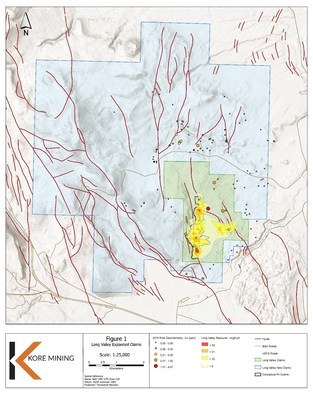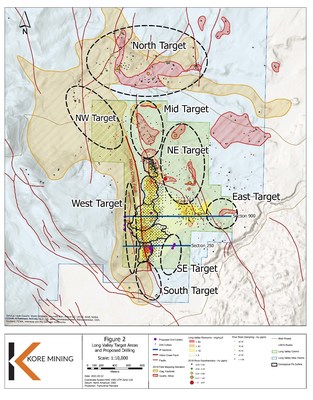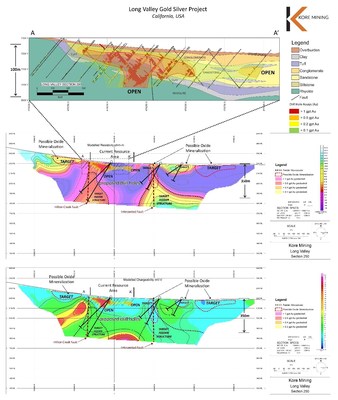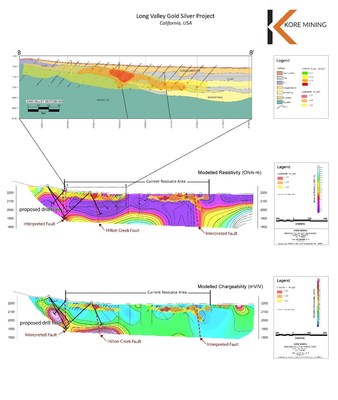Canada NewsWire
Drill Testing Shallow Oxide Expansion and Sulphide Feeder Structure Targets and Expanding Exploration Strategy onto District Scale Claims
VANCOUVER, BC , March 23, 2021 /CNW/ - KORE Mining Ltd. (TSXV: KORE) (OTCQX: KOREF) (" KORE " or the " Company ") is pleased to announce the 2021 exploration plan for the Long Valley gold and silver project ("Project"). The plan includes drill testing the highest priority shallow oxide resource growth targets and the underlying sulphide feeder structure targets. In addition, KORE's exploration strategy will be expanded to the newly staked 14,104 acre district scale claim area and supplemented with a new satellite survey.
HIGHLIGHTS:
- Drill test highest priority shallow oxide resource expansion and untested underlying sulphide "feeder structures" targets - minimum 5,000 meter program
- Potential to expand drilling to 15,000 meters, if warranted
- Drill program permitting in progress with drilling expected to start late in Q2 2021
- Complete in Q2 2021 a satellite multispectral survey to identify alteration, associated with gold mineralization, on entire 15,965 acres of claims
- Expand ground geophysics surveys to generate and refine additional oxide and deeper structural targets
- Further mapping and geochemical sampling on new structural targets
KORE's CEO Scott Trebilcock stated: "Our 2021 exploration plans will extend our successful exploration strategy onto our new district-scale 14,105 acres of claims at Long Valley, opening the potential for discovery of new oxide gold deposits. At the main deposit, we remain on track to drill our exciting resource expansion and underlying feeder zone targets in mid-2021."
Figure 1 shows the project claims with outlines of the current Long Valley resource.
The Company has identified opportunities to expand the shallow oxide mineralization in all directions, further grow by making new discoveries along separate parallel structures and further yet on additional yet unrecognized mineralized structures on the district-scale claims. Additional mineralization could extend mine life, reduce capital intensity and generate higher project economic returns than the 1.2 million ounces of Indicated gold and 0.5 million ounces of Inferred gold from 64 million tonnes of 0.58 grams per tonne and 22 million tonnes of 0.65 grams per tonne, respectively, modelled in the preliminary economic assessment ("PEA") announced October 27, 2020 .
Additionally, as a fully intact epithermal deposit with a large at surface footprint, Long Valley has the potential for high-grade sulphides and discrete vein zones in the underlying feeder structures. The discovery of high-grade, sulphide dominant gold ("Au")-silver ("Ag") mineralization in addition to near-surface oxide Au-Ag mineralization would open up additional development pathways for the Project, such as underground mining and milling of mineralization.
Figure 2 shows a plan of controlling fault structures, drill target areas, drill hole location in permitting and locates cross sections. Figures 3 and 4 layout the highest priority drill targets in section. Drill holes are designed to test both near surface oxide expansion and deeper structures extending below the known resource with multiple holes planned from each pad.
Additional details of the Long Valley exploration targets are in KORE news releases dated January 30, 2020 and March 24, 2020 .
About Long Valley Gold Deposit
The Long Valley deposit is an intact low sulphidation epithermal Au-Ag deposit with a large 2.5 km by 2 km oxide footprint, hosted within a melange of fine to coarse volcanogenic sedimentary lithologies. Mineralization at Long Valley has developed due to a combination of deep-rooted fault structures and a resurgence of rhyolite within an active caldera. The Hilton Creek Fault structure transects and served as a fluid conduit for interaction with the underlying hydrothermal system, while the rhyolite resurgence caused brittle fracturing of sediments and created voids or traps for mineralization and gold deposition. The combination of these factors yields strongly altered kaolin and quartz-hematite zones that are the primary host for gold mineralization.
The Hilton Creek Fault remains underexplored on-strike north and south and several parallel structures have been defined using geophysics, the eastern one hosting some of the current mineral resource and the western one being unexplored. Long Valley is therefore open to potential new oxide discoveries in all directions. More details on the deposit geology and exploration potential can be found in KORE's January 30, 2020 and March 24, 2020 news releases.
About Long Valley Gold Project
Long Valley is 100% owned epithermal gold and silver project located in
Mono County, California
.
Figure 1
shows the claims and mineralized area. The 15,965 acre land package is district in scale and covers all deep-rooted fault structures of similar genesis to the Hilton Creek fault, the primary 'conduit' for the current Long Valley deposit.
A total of 896 holes have been drilled on the Project, the majority being completed by reverse circulation with lesser core, rotary and air track. The current mineral resource estimate is 1,217,000 ounces of Indicated gold and 456,000 ounces of Inferred gold from 63.7 million tonnes of 0.58 grams per tonne and 22.0 million tonnes of 0.65 grams per tonne, respectively. The mineral resource consists of oxide, transition and sulphides. The estimate was prepared Neil Prenn, P.E. of Mine Development Associates with an effective date of September 15 , 2020.
A Preliminary Economic Assessment for a shallow, low-strip heap leach Au-Ag project was filed October 27, 2020 with the following highlights:
- US $273 million NPV5% post-tax with IRR of 48% at US$ 1,600 per ounce gold ;
- Significant leverage to gold: US$ 395 million NPV5% at spot US$ 1,900 per ounce gold;
- 102,000 ounces gold per year over 7 years mine life;
- Technically simple: shallow open pit, heap leach with nearby infrastructure;
- Unmodelled silver potential from metallurgical test-work; and
- Shallow oxide and sulphide feeder exploration potential to further enhance project.
More information is available in the technical report filed on SEDAR at www.sedar.com and on KORE's website at www.koremining.com .
About KORE Mining
KORE is 100% owner of the Imperial and Long Valley gold projects assets in California. Both projects have positive economic assessments that put KORE on the path to produce up to 350,000 ounces of gold production per year. KORE is supported by strategic investor
Eric Sprott
who owns 26% of KORE's basic shares. KORE management and Board are aligned with shareholders, owning an additional 38% of the basic shares outstanding. KORE is actively developing its Imperial Gold project and is aggressively exploring across its portfolio of assets.
Further information on Long Valley and KORE can be found on the Company's website at www.koremining.com or by contacting us as info@koremining.com or by telephone at (888) 407-5450.
On behalf of KORE Mining Ltd
"Scott Trebilcock"
Chief Executive Officer
(888) 407-5450
Technical information with respect to the Long Valley Gold Project contained in this news release has been reviewed and approved by Marc Leduc, P.Eng, who is KORE's COO and is the qualified person under National Instrument 43-101 responsible for the technical matters of this news release.
Neither the TSX Venture Exchange nor its Regulation Services Provider (as that term is defined in the policies of the TSX Venture Exchange) accepts responsibility for the adequacy or accuracy of this release.
Cautionary Statement Regarding Forward-Looking Information
This news release contains forward-looking statements relating to the future operations of the Company and other statements that are not historical facts. Forward-looking statements are often identified by terms such as "will", "may", "should", "anticipate", "expects", "intends", "indicates" and similar expressions. All statements other than statements of historical fact, included in this release, including, without limitation, statements regarding the future plans and objectives of the Company are forward-looking statements. Forward-looking statements in this news release include, but are not limited to, statements with respect to: the actual timing and implementation of the 2021 exploration plan and strategy for the Long Valley Project, the actual timing of completion of the 2021 exploration plan for the Long Valley Project, the opportunities of expansion at the Long Valley Project, the results of the PEA, including future Project opportunities, the projected NPV, permit timelines, the current mineral resource estimate, and the ability to obtain the requisite permits, the market and future price of and demand for gold, and the ongoing ability to work cooperatively with stakeholders, including the all levels of government. Such forward-looking statements, and any assumptions upon which they are based, are made in good faith and reflect our current judgment regarding the direction of our business. Management believes that these assumptions are reasonable. Forward looking information involves known and unknown risks, uncertainties and other factors which may cause the actual results, performance or achievements of the Company to be materially different from any future results, performance or achievements expressed or implied by the forward-looking information.
Such factors include, among others: risks related to exploration and development activities at the Company's projects, and factors relating to whether or not mineralization extraction will be commercially viable; risks related to mining operations and the hazards and risks normally encountered in the exploration, development and production of minerals, such as unusual and unexpected geological formations, rock falls, seismic activity, flooding and other conditions involved in the extraction and removal of materials; uncertainties regarding regulatory matters, including obtaining permits and complying with laws and regulations governing exploration, development, production, taxes, labour standards, occupational health, waste disposal, toxic substances, land use, environmental protection, site safety and other matters, and the potential for existing laws and regulations to be amended or more stringently implemented by the relevant authorities; uncertainties regarding estimating mineral resources, which estimates may require revision (either up or down) based on actual production experience; risks relating to fluctuating metals prices and the ability to operate the Company's projects at a profit in the event of declining metals prices and the need to reassess feasibility of a particular project that estimated resources will be recovered or that they will be recovered at the rates estimated; risks related to title to the Company's properties, including the risk that the Company's title may be challenged or impugned by third parties; the ability of the Company to access necessary resources, including mining equipment and crews, on a timely basis and at reasonable cost; competition within the mining industry for the discovery and acquisition of properties from other mining companies, many of which have greater financial, technical and other resources than the Company, for, among other things, the acquisition of mineral claims, leases and other mineral interests as well as for the recruitment and retention of qualified employees and other personnel; access to suitable infrastructure, such as roads, energy and water supplies in the vicinity of the Company's properties; and risks related to the stage of the Company's development, including risks relating to limited financial resources, limited availability of additional financing and potential dilution to existing shareholders; reliance on its management and key personnel; inability to obtain adequate or any insurance; exposure to litigation or similar claims; currently unprofitable operations; risks regarding the ability of the Company and its management to manage growth; and potential conflicts of interest.
In addition to the above summary, additional risks and uncertainties are described in the "Risks" section of the Company's management discussion and analysis for the year ended December 31, 2019 prepared as of April 27, 2020 available under the Company's issuer profile on www.sedar.com .
Forward-looking statements contained herein are made as of the date of this news release and the Company disclaims any obligation to update any forward-looking statements, whether as a result of new information, future events or results, except as may be required by applicable securities laws. There can be no assurance that forward-looking information will prove to be accurate, as actual results and future events could differ materially from those anticipated in such statements. Accordingly, readers should not place undue reliance on forward-looking information.
There is no certainty that all or any part of the mineral resource will be converted into mineral reserve. It is uncertain if further exploration will allow improving the classification of the Indicated or Inferred mineral resource. Mineral resources are not mineral reserves and do not have demonstrated economic viability.
![]() View original content to download multimedia:
http://www.prnewswire.com/news-releases/kore-mining-announces-2021-exploration-plan-at-the-long-valley-gold-silver-project-301253756.html
View original content to download multimedia:
http://www.prnewswire.com/news-releases/kore-mining-announces-2021-exploration-plan-at-the-long-valley-gold-silver-project-301253756.html
SOURCE Kore Mining

![]() View original content to download multimedia:
http://www.newswire.ca/en/releases/archive/March2021/23/c8546.html
View original content to download multimedia:
http://www.newswire.ca/en/releases/archive/March2021/23/c8546.html




